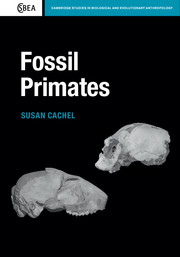Book contents
- Frontmatter
- Dedication
- Contents
- Acknowledgments
- Preface
- 1 Introduction: primates in evolutionary time
- 2 Primate taxonomy
- 3 Fossils and fossilization
- 4 The world of the past
- 5 The lifeways of extinct animals
- 6 Evolutionary processes and the pattern of primate evolution
- 7 Primate origins
- 8 The Paleocene primate radiation
- 9 The Eocene primate radiation
- 10 The Malagasy primate radiation
- 11 The Oligocene bottleneck
- 12 Rise of the anthropoids
- 13 The platyrrhine radiation
- 14 The Miocene hominoid radiation
- 15 The cercopithecoid radiation
- 16 Late Cenozoic climate changes
- 17 Conclusions
- References
- Index
15 - The cercopithecoid radiation
Published online by Cambridge University Press: 05 April 2015
- Frontmatter
- Dedication
- Contents
- Acknowledgments
- Preface
- 1 Introduction: primates in evolutionary time
- 2 Primate taxonomy
- 3 Fossils and fossilization
- 4 The world of the past
- 5 The lifeways of extinct animals
- 6 Evolutionary processes and the pattern of primate evolution
- 7 Primate origins
- 8 The Paleocene primate radiation
- 9 The Eocene primate radiation
- 10 The Malagasy primate radiation
- 11 The Oligocene bottleneck
- 12 Rise of the anthropoids
- 13 The platyrrhine radiation
- 14 The Miocene hominoid radiation
- 15 The cercopithecoid radiation
- 16 Late Cenozoic climate changes
- 17 Conclusions
- References
- Index
Summary
Old World monkeys are called cercopithecoids, after the Superfamily Cercopithecoidea. The earliest cercopithecoid dates to the Oligocene at 25.2 mya. This is Nsungwepithecus gunnelli from the Rukwa Rift in Tanzania (Stevens et al., 2013). The species is represented by a partial mandible with a single tooth. However, this M3 is a bilophodont tooth (Figure 14.5). The bilophodont molar crown pattern of this species heralds both its cercopithecoid status, and its presumed ability to masticate tough, mature leaves. However, microwear on the teeth of the widespread Eurasian Late Miocene colobine Mesopithecus pentelicus indicates that it was a hard-object feeder, like the modern platyrrhine tufted capuchin Cebus apella (Merceron et al., 2009). Hard seeds or fruit may have constituted the preferred diet of Mesopithecus, rather than mature leaves. Folivory could therefore initially have been a fallback dietary strategy for cercopithecoid monkeys. Analysis of the dentition of Victoriapithecus, the most abundant and well known of early cercopithecoids, indicates that it was probably more frugivorous than folivorous (Benefit, 1999).
Detailed analysis of stomach contents of cercopithecoids and hominoids demonstrates that the bilophodont teeth of cercopithecoids allow them to shred leaves into fine strips (Walker & Murray, 1975). Leaves appear to have been pulled across a grater. The bunodont teeth of hominoids merely rumple the leaves—they enter the stomach relatively intact, with only a few puncture marks. The cercopithecoid ability to shred leaves during mastication hastens digestion once leaves enter the stomach. The leaf-eating cercopithecoids or colobines (Subfamily Colobinae) have higher-crowned molar teeth and more pronounced bilophodonty than the cercopithecines. This allows for heavier mastication. Colobines also possess a sacculated stomach in which endogenous bacterial colonies can break down cellulose. This bacterial activity is known from many experiments on economically valuable domesticated cattle. In cattle, anaerobic bacteria in the rumen chamber of the stomach are responsible for breaking down otherwise indigestible plant cellulose while releasing calories and vitamins. The rumen is a center for biofermentation, and the anaerobic bacteria that it contains are therefore indispensable for digesting plant foods. Similar bacterial colonies in the sacculated stomachs of colobines could not only break down indigestible plant fibers, but also de-toxify natural plant alkaloids that would be poisonous to other primates.
- Type
- Chapter
- Information
- Fossil Primates , pp. 247 - 254Publisher: Cambridge University PressPrint publication year: 2015



